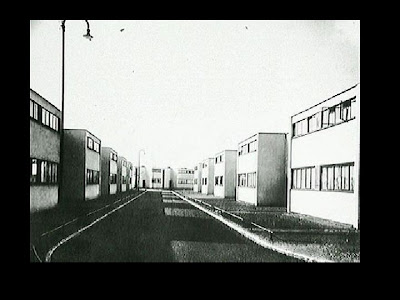Housing is the building block of suburbia, in Germany as in the US. Both countries have their own specific generic postwar houseforms. Here is a speculation on possible NS-era origins of the German suburban vernacular.
The Weimar Republic was a pioneer in modern housing solutions via the [i]siedlung[/i], or housing project. Functional and spartan housing complexes based on ostensible rational design in the service of a notional socialist political economy. Good example is the Torten siedlung outiside of Dessau, in Anhalt province... ...functional and basic, but very cold.
...functional and basic, but very cold.
This was anathama to the culturally conservative National Socialists. Ironically their Fascist brethren in Italy were big fans of modern architecture, appreciating its modern and futuristic quality.
Nazi Germany, though futuristic and modern in some ways, was at heart about ethnolinguistic nationalism run amok and "traditional values", including traditional aesthetic values.
The functionalist comprehensive planning concepts of the Wiemar-era siedlung were appropriated, but the housing took on a somewhat traditionalist form, with sloping roofs and regular windows, including some vestigal traditiongalist detailing, as in this example.... ...replace the sloped roofs with flat and the windows with band windows and this would be a fairly good modernist development.
...replace the sloped roofs with flat and the windows with band windows and this would be a fairly good modernist development.
After the war, during reconstruction and later, one saw modernist housing (which was what was advertised outside of Germany), to show that the new FRG was au-courant, making a break from the NS past.
Yet perhaps more common, though less publiciszed, was the persistance of the NS-style trad forms for mass housing, as a more realistic solution for a country that was mostly in rubble and having to resettle a large refugee population.
Example is this postwar DP colony north of Frankfurt. One can see the retention of the houseforms from the NS era, including little shutters on the windwos. ...and perhaps a more moderinizing example, particularly in the window details:
...and perhaps a more moderinizing example, particularly in the window details: (Siedlung Kreuzberg, outside of Bad Vilbl, northern suburb of Frankfurt)
(Siedlung Kreuzberg, outside of Bad Vilbl, northern suburb of Frankfurt)
Sources for the NS housing aesthetic
One can speculate a bit on where the Nazis were getting their style from. Could it be as simple as the generic German half timbered house. These used to be whitewash and black paint on the wood, so a very stark minimal style... ...take away the timbering, and perhaps rationalizing the window arrangements, and one has a good start at a modern version of a vernacular German houseform.
...take away the timbering, and perhaps rationalizing the window arrangements, and one has a good start at a modern version of a vernacular German houseform.
Another source is the high-design architecture of the era prior to the NS takeover, going as far back as the Arts and Crafts movement. In the US this led to the bungalow. In England there was CR Macintosh and especially CFA Voysey, who employed a very simplified trad style based on cottages and old manor houses.
In Germany there was Heinrich Tessenow, who designed in a stripped classical manner, but combined it with a sort of cottage aesthetic. Perhaps Tessenow was a big influence on NS housing designer.
Heres an example. On the left, two Tessenow designs. On the right an NS housing development in the Saarland. One can see a strong aesthetic affinity, particularly in the gable treatment of the upper example
One can see a strong aesthetic affinity, particularly in the gable treatment of the upper example
Another example of NS housing in the Saarland. This could almost be mis-dated for postwar German suburbia... ...white stucco , normal windows, gable roof. The difference in modern German suburbia is the houses are bigger and somewhat more elaborate in detail, as in this example from north of Frankfurt...
...white stucco , normal windows, gable roof. The difference in modern German suburbia is the houses are bigger and somewhat more elaborate in detail, as in this example from north of Frankfurt... As we know the postwar FRG developed into an exemplary social democratic welfare state. Though they rejected the racist nationalism and militarist expansionism of the NS era, the Germans retained a fondness for trad-derivied housing styles in suburbia. Yet suburban house style never did move into literal revival architecture the way American house construction did.
As we know the postwar FRG developed into an exemplary social democratic welfare state. Though they rejected the racist nationalism and militarist expansionism of the NS era, the Germans retained a fondness for trad-derivied housing styles in suburbia. Yet suburban house style never did move into literal revival architecture the way American house construction did.
Next, a look at modern Eurosprawl in the Frankfurt region.
Wednesday, June 25, 2008
Eurosprawl II: Nazi Suburbia
Subscribe to:
Post Comments (Atom)

2 comments:
Cool post.
I'm interning in Germany right now, and I'm trying to absorb as much as I can from city planning and smart growth practices here that seem commonplace.
Are you in Frankfurt?
Visit my blog to check out what I'm up to here in the Fatherland. A lot is just adventure stories, but I plan on breaking into Dayton-applicable themes like energy, city planning, public transportation, envrionmental policy, community initiatives, etc.
www.onesunonetree.blogspot.com
Not in Frankfurt but have family connections with the place, so somewhat familiar with Germany.
Post a Comment